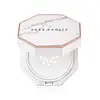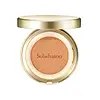Dear Dahlia Skin Paradise Tone-up Sun Cushion SPF 35 PA+++ Versus Sulwhasoo Perfecting Cushion SPF 50+
What's inside
What's inside
 Key Ingredients
Key Ingredients

 Benefits
Benefits

 Concerns
Concerns

 Ingredients Side-by-side
Ingredients Side-by-side

Dahlia Variabilis Flower Extract
Skin ConditioningWater
Skin ConditioningPropanediol
SolventGlycerin
HumectantButyloctyl Salicylate
Skin ConditioningTitanium Dioxide
Cosmetic ColorantDicaprylyl Carbonate
EmollientNiacinamide
SmoothingBehenyl Alcohol
Emollient1,2-Hexanediol
Skin ConditioningCetearyl Alcohol
EmollientArachidyl Alcohol
EmollientCurcuma Longa Root Extract
MaskingSalvia Hispanica Seed Extract
EmollientSimmondsia Chinensis Seed Oil
EmollientLavandula Angustifolia Oil
MaskingCitrus Aurantium Dulcis Peel Oil
MaskingEchium Plantagineum Seed Oil
Skin ConditioningPortulaca Oleracea Extract
Skin ConditioningCentella Asiatica Extract
CleansingHouttuynia Cordata Extract
Skin ConditioningCardiospermum Halicacabum Flower/Leaf/Vine Extract
Skin ConditioningHelianthus Annuus Seed Oil Unsaponifiables
EmollientCamellia Sinensis Leaf Water
MaskingPrunus Amygdalus Dulcis Oil
Skin ConditioningArgania Spinosa Kernel Oil
EmollientOlea Europaea Fruit Oil
MaskingTilia Vulgaris Flower Extract
SoothingArachidyl Glucoside
EmulsifyingPolyglyceryl-2 Caprate
EmulsifyingStearic Acid
CleansingSilica
AbrasiveSodium Stearoyl Glutamate
CleansingAmmonium Acryloyldimethyltaurate/Vp Copolymer
Sorbitan Caprylate
EmulsifyingOctyldodecanol
EmollientSucrose Stearate
EmollientAlumina
AbrasiveGlyceryl Caprylate
EmollientSaccharide Hydrolysate
HumectantSqualane
EmollientEthylhexylglycerin
Skin ConditioningAdenosine
Skin ConditioningDahlia Variabilis Flower Extract, Water, Propanediol, Glycerin, Butyloctyl Salicylate, Titanium Dioxide, Dicaprylyl Carbonate, Niacinamide, Behenyl Alcohol, 1,2-Hexanediol, Cetearyl Alcohol, Arachidyl Alcohol, Curcuma Longa Root Extract, Salvia Hispanica Seed Extract, Simmondsia Chinensis Seed Oil, Lavandula Angustifolia Oil, Citrus Aurantium Dulcis Peel Oil, Echium Plantagineum Seed Oil, Portulaca Oleracea Extract, Centella Asiatica Extract, Houttuynia Cordata Extract, Cardiospermum Halicacabum Flower/Leaf/Vine Extract, Helianthus Annuus Seed Oil Unsaponifiables, Camellia Sinensis Leaf Water, Prunus Amygdalus Dulcis Oil, Argania Spinosa Kernel Oil, Olea Europaea Fruit Oil, Tilia Vulgaris Flower Extract, Arachidyl Glucoside, Polyglyceryl-2 Caprate, Stearic Acid, Silica, Sodium Stearoyl Glutamate, Ammonium Acryloyldimethyltaurate/Vp Copolymer, Sorbitan Caprylate, Octyldodecanol, Sucrose Stearate, Alumina, Glyceryl Caprylate, Saccharide Hydrolysate, Squalane, Ethylhexylglycerin, Adenosine
Ethylhexyl Methoxycinnamate 7%
UV AbsorberTitanium Dioxide 4.15%
Cosmetic ColorantZinc Oxide 9.8%
Cosmetic ColorantWater
Skin ConditioningCyclopentasiloxane
EmollientCI 77891
Cosmetic ColorantCyclohexasiloxane
EmollientPhenyl Trimethicone
Skin ConditioningPEG-10 Dimethicone
Skin ConditioningButylene Glycol Dicaprylate/Dicaprate
EmollientNiacinamide
SmoothingLauryl PEG-9 Polydimethylsiloxyethyl Dimethicone
Skin ConditioningCI 77492
Cosmetic ColorantGlycerin
HumectantPropanediol
SolventAcrylates/Ethylhexyl Acrylate/Dimethicone Methacrylate Copolymer
Skin ConditioningPolyhydroxystearic Acid
EmulsifyingAluminum Hydroxide
EmollientSodium Chloride
MaskingTrimethylsiloxysilicate
EmollientStearic Acid
CleansingTriethoxycaprylylsilane
Parfum
MaskingDisteardimonium Hectorite
StabilisingCI 77491
Cosmetic ColorantButylene Glycol
HumectantEthylhexyl Palmitate
EmollientLecithin
EmollientIsostearic Acid
CleansingIsopropyl Palmitate
EmollientPolysorbate 80
EmulsifyingCaprylyl Glycol
EmollientCI 77499
Cosmetic ColorantHydrogenated Lecithin
EmulsifyingPolyglyceryl-3 Polyricinoleate
EmulsifyingEthylhexylglycerin
Skin ConditioningGlyceryl Caprylate
EmollientPolymethyl Methacrylate
Disodium EDTA
Adenosine
Skin ConditioningHoney
HumectantNelumbo Nucifera Flower Extract
Skin ConditioningPolygonatum Officinale Rhizome/Root Extract
Skin ConditioningRehmannia Glutinosa Root Extract
Skin ConditioningPaeonia Albiflora Root Extract
Skin ConditioningLilium Candidum Bulb Extract
Skin ConditioningBeta-Glucan
Skin ConditioningAlcohol
AntimicrobialPhenoxyethanol
PreservativeTocopherol
AntioxidantSodium Hyaluronate
HumectantAcrylates/Vp Copolymer
Ethylhexyl Methoxycinnamate 7%, Titanium Dioxide 4.15%, Zinc Oxide 9.8%, Water, Cyclopentasiloxane, CI 77891, Cyclohexasiloxane, Phenyl Trimethicone, PEG-10 Dimethicone, Butylene Glycol Dicaprylate/Dicaprate, Niacinamide, Lauryl PEG-9 Polydimethylsiloxyethyl Dimethicone, CI 77492, Glycerin, Propanediol, Acrylates/Ethylhexyl Acrylate/Dimethicone Methacrylate Copolymer, Polyhydroxystearic Acid, Aluminum Hydroxide, Sodium Chloride, Trimethylsiloxysilicate, Stearic Acid, Triethoxycaprylylsilane, Parfum, Disteardimonium Hectorite, CI 77491, Butylene Glycol, Ethylhexyl Palmitate, Lecithin, Isostearic Acid, Isopropyl Palmitate, Polysorbate 80, Caprylyl Glycol, CI 77499, Hydrogenated Lecithin, Polyglyceryl-3 Polyricinoleate, Ethylhexylglycerin, Glyceryl Caprylate, Polymethyl Methacrylate, Disodium EDTA, Adenosine, Honey, Nelumbo Nucifera Flower Extract, Polygonatum Officinale Rhizome/Root Extract, Rehmannia Glutinosa Root Extract, Paeonia Albiflora Root Extract, Lilium Candidum Bulb Extract, Beta-Glucan, Alcohol, Phenoxyethanol, Tocopherol, Sodium Hyaluronate, Acrylates/Vp Copolymer
Ingredients Explained
These ingredients are found in both products.
Ingredients higher up in an ingredient list are typically present in a larger amount.
Adenosine is in every living organism. It is one of four components in nucleic acids that helps store our DNA.
Adenosine has many benefits when used. These benefits include hydrating the skin, smoothing skin, and reducing wrinkles. Once applied, adenosine increases collagen production. It also helps with improving firmness and tissue repair.
Studies have found adenosine may also help with wound healing.
In skincare products, Adenosine is usually derived from yeast.
Learn more about AdenosineEthylhexylglycerin (we can't pronounce this either) is commonly used as a preservative and skin softener. It is derived from glyceryl.
You might see Ethylhexylglycerin often paired with other preservatives such as phenoxyethanol. Ethylhexylglycerin has been found to increase the effectiveness of these other preservatives.
Glycerin is already naturally found in your skin. It helps moisturize and protect your skin.
A study from 2016 found glycerin to be more effective as a humectant than AHAs and hyaluronic acid.
As a humectant, it helps the skin stay hydrated by pulling moisture to your skin. The low molecular weight of glycerin allows it to pull moisture into the deeper layers of your skin.
Hydrated skin improves your skin barrier; Your skin barrier helps protect against irritants and bacteria.
Glycerin has also been found to have antimicrobial and antiviral properties. Due to these properties, glycerin is often used in wound and burn treatments.
In cosmetics, glycerin is usually derived from plants such as soybean or palm. However, it can also be sourced from animals, such as tallow or animal fat.
This ingredient is organic, colorless, odorless, and non-toxic.
Glycerin is the name for this ingredient in American English. British English uses Glycerol/Glycerine.
Learn more about GlycerinGlyceryl Caprylate comes from glycerin and caprylic acid, a fatty acid from coconut. It has emollient and emulsifier properties.
As an emollient, it helps hydrate your skin. Emollients work by creating a barrier on your skin to trap moisture in, helping to keep your skin soft and smooth.
On the other hand, emulsifiers prevent ingredients (such as oil and water) from separating.
Learn more about Glyceryl CaprylateNiacinamide is a multitasking form of vitamin B3 that strengthens the skin barrier, reduces pores and dark spots, regulates oil, and improves signs of aging.
And the best part? It's gentle and well-tolerated by most skin types, including sensitive and reactive skin.
You might have heard of "niacin flush", or the reddening of skin that causes itchiness. Niacinamide has not been found to cause this.
In very rare cases, some individuals may not be able to tolerate niacinamide at all or experience an allergic reaction to it.
If you are experiencing flaking, irritation, and dryness with this ingredient, be sure to double check all your products as this ingredient can be found in all categories of skincare.
When incorporating niacinamide into your routine, look out for concentration amounts. Typically, 5% niacinamide provides benefits such as fading dark spots. However, if you have sensitive skin, it is better to begin with a smaller concentration.
When you apply niacinamide to your skin, your body converts it into nicotinamide adenine dinucleotide (NAD). NAD is an essential coenzyme that is already found in your cells as "fuel" and powers countless biological processes.
In your skin, NAD helps repair cell damage, produce new healthy cells, support collagen production, strengthen the skin barrier, and fight environmental stressors (like UV and pollution).
Our natural NAD levels start to decline with age, leading to slower skin repair, visible aging, and a weaker skin barrier. By providing your skin niacinamide, you're recharging your skin's NAD levels. This leads to stronger, healthier, and younger looking skin.
Another name for vitamin B3 is nicotinamide. This vitamin is water-soluble and our bodies don't store it. We obtain Vitamin B3 from either food or skincare. Meat, fish, wheat, yeast, and leafy greens contain vitamin B3.
The type of niacinamide used in skincare is synthetically created.
Learn more about NiacinamidePropanediol is an all-star ingredient. It softens, hydrates, and smooths the skin.
It’s often used to:
Propanediol is not likely to cause sensitivity and considered safe to use. It is derived from corn or petroleum with a clear color and no scent.
Learn more about PropanediolStearic Acid is a fatty acid. It is an emollient, emulsifier, and texture enhancer.
As an emollient, stearic acid helps soften skin. It aids the skin's protective barrier by preventing water loss. It also provides a gentle cleansing effect without stripping away natural oils.
Stearic acid may also be used to enhance the texture of products. It can add volume and stabilize ingredients such as water and oil. This can help water and oil ingredients from separating.
Sources of stearic acid include animal or vegetable fats/oils such as coconut or shea. It can be naturally found in butter, cocoa butter, shea butter, vegetable fats, and animal tallow.
This ingredient may not be Malassezia folliculitis, or fungal-acne safe.
Learn more about Stearic AcidTitanium dioxide is a mineral UV filter widely used in sunscreens and cosmetics.
It is one of only two UV filters officially classified as “mineral” by regulatory agencies, the other being zinc oxide.
Titanium dioxide provides broad-spectrum protection mostly in the UVB and UVAII range, with some protection in the UVAI range.
While its UVA protection isn’t as strong as zinc oxide’s, the difference is minor.
A common myth is that mineral UV filters reflect UV light. However, modern research shows titanium dioxide absorbs UV radiation like chemical filters (~95% absorption & 5% reflection).
Thanks to its non-irritating nature, titanium dioxide is suitable for sensitive, acne-prone, or redness-prone skin. It is unlikely to cause "eye sting" like other sunscreen ingredients.
A major drawback of this ingredient is its white cast and thick texture. This is why mineral sunscreens often leave a white cast and are less cosmetically elegant than chemical/hybrid sunscreens.
To improve white cast and spreadability, micronized or nano-sized titanium dioxide is often used.
There are ongoing concerns surrounding nano-titanium oxide's impact on marine ecosystems.
There is no conclusive evidence that any form of titanium oxide (or any other sunscreen ingredients) will cause harm to marine ecosystems or coral reefs. The science is still developing but many consumers are keeping a close eye on this issue.
Please note, many destinations have reef-safety sunscreen rules. For instance, the U.S. Virgin Islands advises all visitors to use non-nano mineral sunscreens.
Nano mineral sunscreens once raised safety concerns about absorption into skin.
Extensive research has shown that they do not penetrate healthy or damaged skin; they remain safely on the surface and the top layer of dead skin (stratum corneum).
You'll likely find titanium dioxide bundled with alumina, silica, or dimethicone. These ingredients help make titanium dioxide highly photostable; this prevents it from interacting with other formula components under UV light.
Learn more about Titanium DioxideWater. It's the most common cosmetic ingredient of all. You'll usually see it at the top of ingredient lists, meaning that it makes up the largest part of the product.
So why is it so popular? Water most often acts as a solvent - this means that it helps dissolve other ingredients into the formulation.
You'll also recognize water as that liquid we all need to stay alive. If you see this, drink a glass of water. Stay hydrated!
Learn more about Water